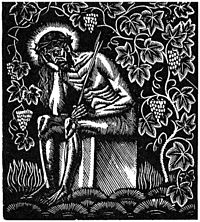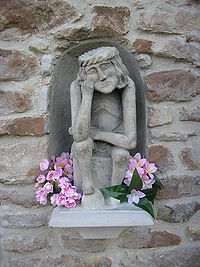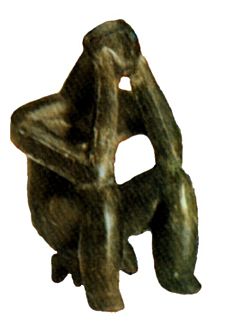- Pensive Christ
-
The Pensive Christ or Christus im Elend ("Christ in Distress" in German) is a subject in Christian iconography depicting a contemplating Jesus, sitting with his head supported by his hand with the Crown of Thorns and marks of his flagellation. It is therefore a picture of Jesus shortly before his crucifixion, although more an andachtsbilder or devotional subject than intended to show an actual moment in the narrative of the Passion of Christ. The Pensive Christ is much more common in sculpture than in painting, where the similar Man of Sorrows is more often depicted (in this Jesus is shown with the wounds of the crucifixion).
Contents
Development of the image
Similar images are known fron Neolithic sculptures in Europe, dating several thousand years before Christ. [1] The first known depictions of the Pensive Christ occur in northern German sculptures from the latter half of the 14th century, taking a pose already found in paintings of the preparations for the crucifixion, where Jesus sits in thought as the soldiers work to raise the cross. Before this the pose had been used for the figure of Job in Distress, according to typology one of the prefigurements of Christ.[2] Art historians link its appearance with the Devotio Moderna (Latin for "modern devotion"), which stressed the human nature of Jesus, a model for the faithful to follow. The image became especially popular in Silesia and Pomerania, and then Poland and Lithuania[3], where it became strongly entrenched in folk art wood carvings by dievdirbiai (Lithuanian folk carvers; example below).
A related image, the Herrgottsruh ("Repose of the Lord" in German), does not have the chin resting on a hand; Christ sits, often with hands crossed in his lap. This appeared in Italian painting at the end of the 14th century, and soon spread to sculpture in southern Germany and Austria.[4]
The Thinker by Auguste Rodin has a similar pose, and may be based on the traditional sculptures.
Gallery
-
Job, in his traditional pose, by Albrecht Dürer
-
16th century sculpture from the Jura
See also
Notes
- ^ Gimbutas, Marija. "The 'Sorrowful God'". The Goddesses and Gods of Old Europe 6500-3500 B.C. Myths and Cult Images. Berkeley and Los Angeles: University of California Press. pp. 230–234. ISBN 0520046552. "There are figures of a squatting or seated man on a stool or a throne; his arms either rest peacefully on his lap, or they are propped on his knees to provide a support for his head...the facial expression...imply contemplation and worry"
- ^ Schiller, 84-85
- ^ "Rupintojelis- Worrying Christ Statue". http://sydneyadelaidetuntas.com/Rupintojelis.pdf. Retrieved 2008-06-22.
- ^ Schiller, 73
References
- Schiller, Gertrud; Iconography of Christian Art, Vol. II,1972 (English trans from German), Lund Humphries, London, ISBN 853313245
External links
- Photographs of folk figurines of Pensive Christ in Lithuania (in Lithuanian) http://www.tradicija.lt/Siuzetai/BA_Rupintojeliai_a.en.htm
Categories:- Iconography of Jesus
- Lithuanian Folk art
- National symbols of Lithuania
- Christianity stubs
- Lithuania stubs
- Poland stubs
-
Wikimedia Foundation. 2010.







